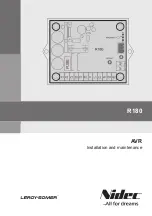
9. Turn “POT1” (labeled as “IN1_PWM” on silkscreen) clock-wise. The motor should start spinning and its
speed should increase as the POT is turn more clockwise.
10. Slowly turn VREF counter clockwise while probing the VREF test point, this should allow you to set VREF to
the desired value for current regulation. If not current regulation is desired then leave VREF fully clockwise.
11. Turn “IN1_PWM” POT all the way counter-clockwise. Motor should come to a complete stop.
12. Turn “IN2_PWM” POT clock-wise. Motor should begin to spin the opposite direction of step
5.1 H-Bridge Control
Table 5-1. H-Bridge Control
IN1
IN2
OUT1
OUT2
DESCRIPTION
0
0
High-Z
High-Z
Coast; H-bridge disabled to High-Z (sleep entered after 1 ms)
0
1
L
H
Reverse (current OUT2 → OUT1)
1
0
H
L
Forward (current OUT1 → OUT2)
1
1
L
L
Brake; low-side slow decay
The inputs can be set to static voltages for 100% duty-cycle drive, or they can be pulse-width modulated (PWM)
for variable motor speed. When using PWM, switching between driving and braking typically works best. For
example, to drive a motor forward with 50% of its max RPM, IN1 = 1 and IN2 = 0 during the driving period, and
IN1 = 1 and IN2 = 1 during the other period. Alternatively, the coast mode (IN1 = 0, IN2 = 0) for
fast current
decay
is also available. The input pins can be powered before VM is applied.
FORWARD
REVERSE
OUT1
OUT2
2
1
2
2
Forward drive
Slow decay (brake)
VM
1
OUT1
OUT2
2
1
2
2
Reverse drive
Slow decay (brake)
VM
1
3
3 High-Z (coast)
3 High-Z (coast)
3
Figure 5-3. H-Bridge Current Paths
5.2 Current Sensing and Current Regulation Details
The current sensing and current regulation will depend on the device used:
DRV8251AEVM and DRV8231AEVM:
An internal current mirror architetcture on the IPROPI pin implements current sensing and regulation. This
eliminates the need for a large power shunt resistor, saving board area and reducing system cost. The
IPROPI current-sense output allows a microcontroller to detect motor stall or changes in load conditions.
VREF determines the threshold of current regulation during start-up and stall events without interaction of a
microcontroller.
Operation of the EVM
SLVUC78 – NOVEMBER 2021
DRV8251/AEVM User's Guide
7
Copyright © 2021 Texas Instruments Incorporated




























